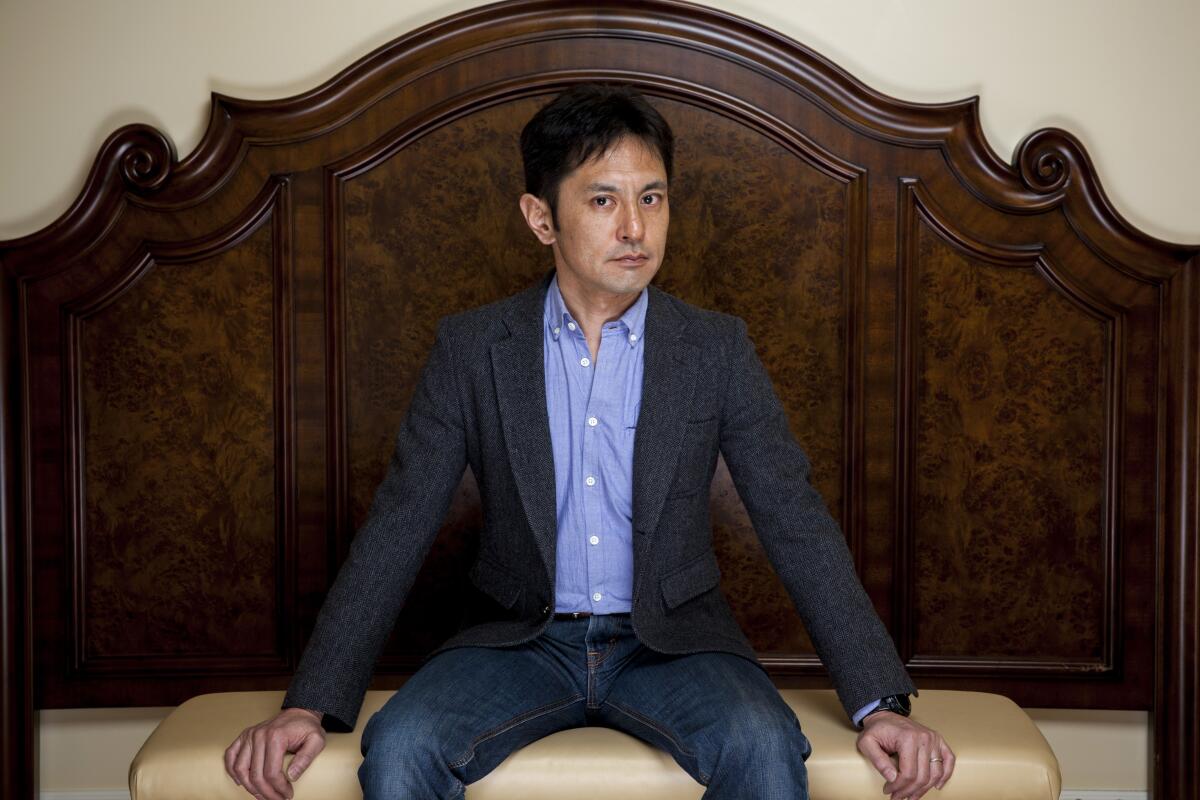‘Earwig and the Witch’ director Goro Miyazaki on his ‘sacrilegious’ Studio Ghibli movie

- Share via
“Earwig and the Witch” is about a young orphaned girl who is not afraid to do what she has to do to get what she wants.
Her personality alone sets her apart from a majority of the heroes depicted in the films from Studio Ghibli. But she’s also the central character of the acclaimed Japanese animation studio’s first-ever 3DCG feature.
“Earwig is this protagonist who talks about controlling people and is someone that always tries to get payback,” said director Goro Miyazaki. “She is not a proper good kid, really, and I thought that made her very charming.
“I wanted to portray her,” he added, “as someone who is energetic and honest about her wants who just doesn’t fit the ‘good kid’ mold.”
After working on the computer-animated TV series “Ronja, the Robber’s Daughter,” Miyazaki returned to Ghibli with an eye toward working on a CG feature. When the project he had been preparing for fell through, Ghibli co-founders Hayao Miyazaki — his father — and Toshio Suzuki approached him about directing “Earwig and the Witch.”
“Earwig,” which is available to stream on HBO Max, is Goro Miyazaki’s third feature, and he said he particularly enjoyed tackling the comedic elements on the film. Each of his Ghibli films, which also include 2006’s “Tales From Earthsea” and 2011’s “From Up on Poppy Hill,” have been distinct in topics and themes. And “Earwig” is the first of the three that feels particularly suitable for a younger audience.
Though Miyazaki laughed off questions about Ghibli’s future, saying it was something he was trying not to worry about, the director discussed with The Times his film “Earwig and the Witch,” Japanese 3DCG animation and black cats that talk. This conversation has been edited for clarity and length.
‘Earwig and the Witch,’ Studio Ghibli’s first foray into 3DCG animation, is an adaptation of Diana Wynne Jones’ book about a mischievous girl with a hankering for magic.
What was it that made you think “Earwig’s” story was something that would work in 3DCG?
After working on “Ronja” and making a computer-animated TV show, I came to see that there are allures and possibilities unique to CG as much as there are with hand-drawn animation.
Then I was handed the plans for “Earwig” and I thought it felt just right. As a story that focuses on a handful of characters in limited situations, it felt like the perfect scope for Ghibli’s first full-CG endeavor.
What are these allures you found that are specific to CG animation?
I think that there are certain advantages in CG with regard to character animation and acting.
For example, a minute-long one-shot scene is extremely hard to do in hand-drawn animation, particularly if it involves detailed acting. With hand-drawn animation, you first have to get the drawing right, and these proper drawings have to seamlessly convey the detailed acting. So creating good acting requires finding an artist with the right technique, experience and sensibilities, which is very difficult.
But with CG it’s possible to have different people contribute to one scene, so there is this possibility of raising the bar on the quality of the acting. That was very appealing to me.
Computer animation encompasses a range from the flatter, cel-shaded style to the more photo-realistic kind. How did you decide on what visual approach to use for “Earwig”?
If you go too far in the photo-real direction, it’s that much closer to live-action and would move things further away from the type of animated movies we want to do, so-called manga movies. That said, using a cel-shading technique like “Ronja” to mimic cel animation also doesn’t really make sense for Ghibli.
Ghibli has done hand-drawn cel animation for so long, going out of the way to use CG just to re-create that look feels unnecessary. So what we ended up looking to was stop-motion animation like the work at Laika and Aardman. We ultimately decided crafting CG that looks like stop-motion would be a good style to pursue.
Having it be 3DCG that was reminiscent of the drawings that Ghibli has done for so long was also something always on our minds.
So you wanted to make a movie that was both “Ghibli-like” and in 3DCG?
I agree it’s sacrilegious when you really think about it. It’s hard to put into words, really, but my thought throughout the whole production process was that the movie would be a success if it was something that people could watch and say, “It’s CG, but it’s still Ghibli-like.”
HBO Max launched with all but one Studio Ghibli movie in its library. This is the best order to watch them.
Is there a unique stress or pressure that comes with working on a Ghibli project?
I actually didn’t feel much pressure because this movie is in 3DCG. There’s much more pressure when working on a hand-drawn project because you are working within the realm of Hayao Miyazaki and other gifted creators, and you’re sort of competing to be at that level. I feel like, because this one was in 3DCG, I was working outside of that and was able to have fun throughout the process.
What inspired you to incorporate Earwig the rock band and that backstory?
Rock music made sense because the story takes place in an England-like place, but some time in the not-too-distant past.
The backstory about Earwig’s mother being in a rock band came about because we knew she was being chased by those 12 witches. To me that implied she was a person who did something to make the 12 witches dislike her or that she broke some rules. So I imagined her to be someone with a bit of a rebellious streak.
Since we were already doing something new by making a 3DCG movie, I thought we might as well do something new with the music too. And I personally like rock music.
“Earwig” is a movie with a young girl witch and talking black cat. Were you worried at all about being compared with Ghibli’s other movie with a young girl witch and a talking black cat?
I wasn’t really worried about it. But the character designer for “Earwig” is Katsuya Kondo, who also designed Kiki and Jiji for “Kiki’s Delivery Service.” So when we approached him about designing another black cat, he did worry that the cats looked the same no matter how many attempts he made.
Did you find anything particularly difficult to animate or encounter any challenges that were specific to “Earwig”?
Everything was a first for me, so everything was difficult in its own way.
But along the lines of that idea of trying to maintain our “Ghibli-ness,” Ghibli films are known for their scenes involving food and cooking and eating. I don’t think there are a lot of CG works that are as serious in their depiction of food, so that was one of the areas I really focused on getting right.
It might seem like a small thing, but it definitely was a challenge.
How would you compare the production process between CG and hand-drawn works?
To put it very simply, in hand-drawn animation, you just have to draw it. A character that’s just going to appear briefly, you just have to draw them. A background that’s going to pass by in a flash, you just have to draw it.
But in CG, even a character that only shows up briefly, you have to properly model them and set everything up. The time that it takes to prepare even the small things was something that left an impression with me.
Of course there are a lot of other differences in the process. But that sense of “we just have to draw it” is unique to hand-drawn animation. And how, even if you’re running out of time, there’s this feeling that if you just work hard enough, you can get everything done.
But with CG, you have think about the time it takes for the computer to process and render things and stuff like that, so the timeline is not just up to you working hard to get the drawings done.
There is an impression that Japanese animation fans in the U.S. are a bit hesitant toward 3DCG anime, but how is it in Japan?
I would say it’s similar here. People will watch and enjoy the 3DCG movies from studios like Disney and Pixar and even Illumination. But they hate 3DCG works that are made here. I think there is this belief that if you’re Japanese, you should be making hand-drawn cel animation.
But I also think that’s just among the adults. Children aren’t concerned about whether something is 3DCG or cel animation, or whether something was made in Japan or abroad.
But it seems like there have been more Japanese works in 3DCG lately, like the recent “Doraemon” and “Lupin III” movies.
Yes. But while people have responded positively to them, there are also those who question why these characters who have been hand-drawn for so long were changed to 3-D.
I think part of it, though, has to do with the projects. 3DCG can still feel risky in Japan, so there has been a tendency to push projects that seem safe, like those featuring characters that are already well known and beloved like Doraemon and Lupin III. But I think that actually also opens these projects up for certain comparisons and particular criticisms.
I think things could change in Japan if more original or new projects can find success in 3DCG.
How was it for you working on a new 3DCG project within this environment?
It was fun. With CG, as long as you’re using the same software, you can work with anyone anywhere around the world. So many people who worked on “Earwig” were from outside of Japan, and it was fun working with people from places like Taiwan, Malaysia, Singapore and France.
To put it broadly, animation made in Japan is fairly still. If you think about kabuki, there are a lot of moments where there is a pause for effect. People stop, then talk, then move, and it’s a flow that also exists in our animation.
But for people overseas, who may have been more influenced by Disney, there’s this sense that animation involves constant movement and you’re adding the acting on top of that. So for “Earwig” it was fun finding the balance between the two — an Earwig that would have been extremely still and an Earwig that would have been constantly in motion.
More to Read
Only good movies
Get the Indie Focus newsletter, Mark Olsen's weekly guide to the world of cinema.
You may occasionally receive promotional content from the Los Angeles Times.










